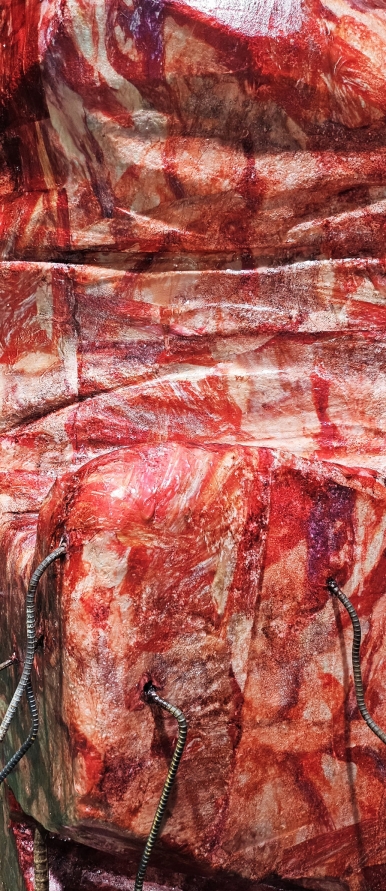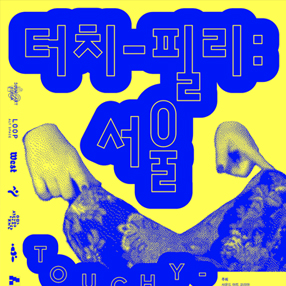본문
-

전시포스터
-
홍혜림
<발작적! 너무나도 웃기는 되먹임> 부분 이미지 2024
홍혜림
<발작적! 너무나도 웃기는 되먹임> 부분 이미지 2024
홍혜림
<발작적! 너무나도 웃기는 되먹임> 부분 이미지 2024
홍혜림
<발작적! 너무나도 웃기는 되먹임> 부분 이미지 2024
Press Release
The exhibition begins with the etymology of ‘hysteria,’ which comes from the ancient Greek word ‘hystera,’ meaning ‘uterus’. Unlike the contemporary understanding of hysteria as a form of extreme mental excitement or neurosis, historically, it was considered a women’s disorder. Ancient scholars and doctors attributed this condition to the female reproductive organ, diagnosing symptoms such as anger, gluttony, irritability, and various mental disorders as inherently female traits.
Hong grew up in a large family that lived together in a traditional Korean house known as a hanok. This house was built by her grandfather and housed four generations, including her mother, grandmother, and great-grandmother. In the early 1990s, her father, an architect, constructed a modern house for the family. The artist recalls her childhood as composed of men doing construction work and women (mother, mother-in-law, and mother-in-law’s mother-in-law) cooking. Growing up in this environment, which spanned different generations and eras, Hong often imitated the men on the construction site and played with construction materials.
To this young artist, the cement pouring out of the concrete mixer truck resembled excrement being expelled from an anus. The men engaged in repetitive activities like erecting rebar, kneading the cement, and transporting construction materials, while the women performed the housework. The house’s architectural design did not accommodate domestic labor well, making it difficult for women to straighten their backs. This experience inspires the artist’s vision of wanting to ‘straighten the backs of the mothers,’ much like the rebar erected by the fathers.
Hong’s work is based on her childhood experiences of gender role segregation, her experiences as an Asian woman studying in Germany, her position as an artist, the distinctions between male and female as imposed by language (such as the use of articles in German), and the discomfort she finds in the observations (which she describes as ‘regrettable’). She uses the body and specific words as metaphorical vehicles to challenge and subvert their original meanings, deconstructing and reconstructing objects, language, materials, and methods typically associated with either gender.
The exhibition features a set of ten sculptures made of construction materials. Expressions of hysteria, historically considered a female ailment, and the language women use to express disgust and unpleasant emotions are redesigned with materials from construction sites, which are predominantly male-dominated spaces. Structures that are intended to be ‘erected’ for human convenience are arranged in uncomfortable ways. The installed artworks have no titles; only the building materials used in their creation are listed. The red mass, resembling scratched mucous membranes or the inside of organs, is the product of patriarchy mixed with ‘expanded polystyrene, vinyl, ink, mortar cement, rebar, construction coatings (adhesives or waterproofing agents), pipe fittings, round steel pipes, galvanized iron sheets, wire mesh, pipe insulation’ which the artist observed in her childhood. Materials of men—a mass of aimless architectural shapes, loosely assembled ‘hemorrhoid chairs,’ and hardened, tangled structures—stand erect, deprived of their original utility.
The red installation, a sagging mass of red, speaks of women’s skin, defined by men as weak. The phrase in the exhibition title in Korean, ‘발작적, 너무나도 웃기는,’ which translates to ‘convulsive, hilarious,’ is a lexical play on the word ‘hysterical.’ Borrowing from the mechanisms of disorder, the exhibition aims to provide feedback rather than treatment. (The women) ‘don’t get diagnosed; they feed back everything of hysteria.’
Written by Sun Mi Lee, Curator of Alternative Space LOOP
전시는 ‘히스테리’의 어원에서 출발한다. 히스테리는 ‘자궁’을 뜻하는 고대 그리스어 히스테라Hystera에서 기원했다. 극도의 정신적 흥분상태 혹은 신경증의 유형으로 분류되는 현대의 의미와는 달리 과거 히스테리는 여성의 질병으로 여겨졌다. 고대 학자, 의사들은 히스테리의 원인을 여성 생식기인 자궁 때문이라 말하며, 분노, 폭식, 과민, 정신질환 등의 증상은 여성의 것이라 진단한다.
홍혜림은 대가족이 한 집에서 생활하던 유년시절을 보낸다. 할아버지가 지은 오래된 한옥에서 엄마, 할머니, 증조할머니까지 4대가 함께 살았고, 90년대 초반 건축가인 아버지는 가족을 위해 현대식 주택을 짓는다. 작가가 기억하는 어린 시절은 건설 노동하는 남성과 밥을 짓는 여성들(어머니, 시어머니, 시어머니의 시어머니)로 구성된다. 세대와 시대가 혼합된 환경에서 작가는 건설 현장의 남성들을 흉내 내며 건축자재를 놀잇감으로 성장했다.
어린 작가에게 레미콘(회반죽차)에서 쏟아지는 시멘트는 항문에서 나오는 배설물로 보였다. 남성들은 철근을 세우고 배설물을 반죽하고, 자재를 나르는 등의 행위를 반복했고, 여성들은 집안일을 반복했다. 가사노동을 고려하지 않은 집의 구조로 인해 여성은 제 허리를 펴기 어려웠다. 작가는 아버지(들)가 세우는 철근처럼 ‘어머니들의 허리를 꼿꼿이 세워주고 싶다’고 상상한다. ‘
홍혜림의 작업은 젠더 역할이 구분되었던 어린 시절의 경험과 독일 유학시절 느꼈던 동양 여성의 위치, 예술가의 위치, 단어에 규정된 남성과 여성의 존재(독일어의 관사article 사용에서), 그 안에서 발견하는 불편함(작가는 ‘유감’스럽다고 표현한다)을 기반으로 작업을 진행한다. 신체와 특정 단어를 은유적 매개체로 사용해 본래의 의미를 좌절시킨다. 남성의 것과 여성의 것으로 규정된 대상, 언어, 물질, 방식 등을 해체하고 재조립하는 방식이다.
전시는 건축 자재로 만들어진 열개의 조각 세트로 구성된다. 여성의 질병으로 여겨진 히스테리, 혐오스럽고 불쾌한 것들을 표현하는 여성 언어들은 (주로 남성들이 참여해 온) 공사판의 재료들로 다시 설계된다. 인간의 편의를 위해 ‘세워’져야 할 건축물들은 불편하게 나열된다. 설치된 예술 작품에 제목은 존재하지 않는다. 제작에 쓰여진 건축 재료만 나열될 뿐이다. 마치 생채기난 점막, 장기의 내부처럼 보이는 빨간 덩어리는 그가 어린 시절 지켜본 ‘발포 폴리스타이렌, 비닐, 잉크, 몰탈 시멘트, 철근, 건축용 코팅/ 접착/ 방수제, 배 관 파이프 피팅, 원형 쇠파이프, 함석판, 와이어 메쉬, 파이프 보온재’ 등이 혼합된 가부장제의 산물이다. 목적이 없는 건축물 형상의 덩어리, 얼기설기한 치질 의자, 재료들을 굳히고 엉켜 나열한 구조물 등 남성들의 재료는 본래의 쓰임새를 잃고 꼿꼿이 서있다.
빨갛게 세워진 설치물, 늘어진 붉은색 덩어리들은 남성에 의해 나약한 존재로 규정지어진 여성의 피부라고 말한다. 전시의 제목인 ‘발작적, 너무나도 웃기는’은 히스테리컬Hysterical의 국어사전적 변형이다. 질병의 기제를 빌려온 이번 전시는 치료가 아닌 되먹임Feedback을 목적으로 한다. (그녀들은) ‘진단받지 않는다. 히스테리의 모든 것을 되먹는다.’
글: 이선미, 대안공간 루프 큐레이터
홍혜림
서울에서 살고, 작업한다. 건축 노동과 재료에 대한 양가감정을 기반으로, 건축 재료를 주재료로 갖고 작업하고, 전시를 만든다. 2019년 귀국해 첫 개인전을 가졌고, 건축 기술 노동자들과의 협업을 시작하며 돌출되어 부적합한, 이물질이며 미해결인 부분을 의미하는 ‘버’라는 개념을 다양하게 매개하여 전시를 만들었다. 신체와 신체 사이, 신체와 정신 사이에서 서로 뒤엉키거나 튕겨져 나가는 것들에 관심을 두고, 재료와 그에 따른 노동 방식, 언어를 중첩하여 다양한 형태의 몸체를 만든다. 최근에는 촉각을 주된 감각으로 건축 액체 재료로 조각하는 방법을 시도한다. 독일 뮌스터 미술대학교에서 디폴롬, Suchan Kinoshita에 마이스터슐러를 사사했다. (2018) 최근 개인전으로는 ‘키스! 키스 마이 버, 청주미술창작스튜디오, 청주(2023), ‘너무 작은, 중간의, 너무 큰 버’, Hall 1, 서울(2023), ‘너무 작은, 너무 큰 버’ 천안시립미술관, 천안(2022) 등이 있다. 청주미술창작스튜디오(청주시립미술관, 2023), 푸른지대 창작샘터(수원문화재단, 2022)의 레지던시 프로그램에 참여했으며, 현재 금천예술공장(서울문화재단)에 입주해 있다.전시제목홍혜림 개인전: 발작적! 너무나도 웃기는 되먹임
전시기간2024.08.02(금) - 2024.08.31(토)
참여작가 홍혜림
관람시간10:00am - 07:00pm
휴관일일,월,설날 연휴 휴관
장르설치
관람료무료
장소대안공간 루프 ALTERNATIVE SPACE LOOP (서울 마포구 서교동 335-11 )
주최홍혜림
주관홍혜림
후원서울특별시, 서울문화재단 / 협력: 대안공간 루프
연락처02-3141-1377
Artists in This Show
대안공간 루프(ALTERNATIVE SPACE LOOP) Shows on Mu:um
Current Shows






















